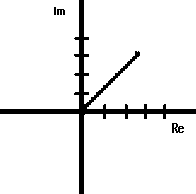|
Summary Complex numbers can be represented in cartesian form (a + bi) or in polar form (r*e^(i * theta) ). The magnitude of a complex number is found by multiplying by its complex conjugate (a-bi) and then taking the square root of the product. In polar form, r is the magnitude. Imaginary Numbers: What are they? Easy answer: The square root of -1 is represented by the number "i". "i" looks like a variable but it is not; it is the number such that its sqaure equals negative one. The square roots of other negative numbers can be represented in terms of i. For example, the square root of -9 is 3i. Tricky stuff: How a negative number can even have a square boggles the mind. That's why "i" is imaginary, I suppose, but the fact that we defined and use it is funky. Another point: don't all numbers have two square roots? The square root of 9 is 3 and -3. What about -1? It should have two roots as well (since we said that it is allowed to have roots). Maybe -i will work as well (just like -3 works for 9). Well, if we square -i we get (-i) * (-i) = (-1)i * (-1)i = i * i = -1. Another
point: imaginary numbers have real squares. Why? When you square
a number b*i (like 3i, or -6i), you get: So no matter what number b you choose, you get a real result. Fourth powers are another matter, but sticking to squares we are safe. Whoa. So +i and -i have the same square. Why do we choose one over the other? I shall return to this shortly, but for now I will let the excitement build. Complex Numbers We
now have two types of numbers: real, which are all the regular
numbers you know and love, and imaginary numbers, the numbers that
are square roots of negative numbers. It is easy to tell them
apart: imaginary numbers have an "i". Real numbers
don't. Now, complex numbers are numbers which
have two parts: a real part and an imaginary part. One way
to write them is like this: a + bi. "a"
is the real part (no i) and "bi" is the imaginary part
(has an i). An example of some complex numbers are: z = a +bi (z is complex, a and b are real). Notice that z is a single number. It has two components, but it is still one number. Think of it in terms of fractions: a fraction is a single number that has two parts: a numerator and a denominator. In general, each component of the fraction is different from the fraction itself. The same goes for complex numbers: z has two components (1 real and 1 imaginary), and each component alone is (generally) different from z. The components combine to create the complex number z. Graphing
Complex Numbers We
draw a vector from the origin (0,0) to the point (a, b) that represents
the complex number. 3 +3i looks like this, with imaginary
numbers on the vertical and real numbers on the horizontal:
For
example, the point (1,1) in cartesian is (2^.5, 45) in polar.
45 represents the direction (45 degrees above the horizontal) and
2^.5 represents the amount of distance to go (thank you Pythagoras).
The angles start at zero and go counter-clockwise. To go 1 unit
downward: Polar:
( r, theta ) [An
aside: To express a point in two dimensions you need two peices
of data. We are used to the data coming in an (x,y) pair.
Now we see it can also be represented as an (r, theta) pair.
Are there any more ways to represent a point on a plane? To represent
a point in three dimensions, we need three pieces of data. There
are a few ways to do this (link).] Incredible Math Relation Ok,
I'll admit that very few things in math can be called "exciting".
Intersting, maybe (don't roll your eyes) but exciting? This,
my friends, is one of those rare moments. I was in hysterics
when I first learned of it. The relation is: This
formula is just... amazing. It relates e, which is an irrational
(infinite decimal places) and funky number to begin with, to i,
an imaginary numbers, and also to sine and cosine, which are just
regular functions that have rational values . Whoa.
To see why it is true, click here. For example, e^(i*pi) =
-1. That equation has two irrantional numbers, and somehow
the exponential e pops out a negative number. Ok, that's enough
blathering about the beauty of that equation, let's see what it
can do. z = a +bi or z = re^(i*theta) The
rules for converting between the two are the same. r = sqrt(a^2
+ b^2) and theta = arctan(b/a) Complex
Conjugates and Magnitudes Magnitude = sqrt( (a+bi) * (a -bi) ) = sqrt(a^2 +abi -abi + b^2) = sqrt(a^2 + b^2). It
looks just like the formula for regular cartesian coordinates!
(Pythagorean theorem to find lengths). Thus, the magnitude
of (3 + 4i) is sqrt(9 + 16) = 5. On a last note, if you want
to find the complex conjugate of any complex number, just
switch all the i's to "-i". It doesn't matter if
they are in exponentials or denominators or inside square roots:
just switch them all. For complex numbers in polar form (re^(i*theta)),
the magnitude is just r. |
|||||
Last modified: 12/2/01
